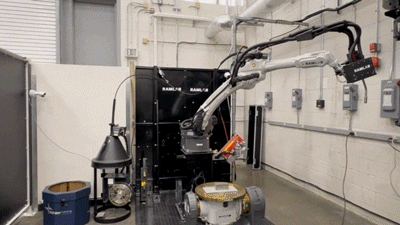Johns Hopkins APL’s Robotic Arm Targets Maritime Resilience
To strengthen the U.S. maritime industrial base, the Johns Hopkins Applied Physics Laboratory (APL) in Laurel, Maryland, has introduced a new industrial robotic arm into its advanced manufacturing facility. The RAMLAB MaxQ system will serve as a research platform for testing and validating robotic repair and additive manufacturing methods that could make ship maintenance faster, cheaper, and more accessible to smaller industry partners.
“Repair is a difficult challenge to solve in maritime sustainment, but it’s critical we do so because it’s often faster than building parts from scratch,” said James Borghardt, APL’s Expeditionary Logistics program manager. “With this new tool, APL can validate and refine additive manufacturing techniques that make repair more practical for our government and industry partners — ultimately improving the agility and resiliency of the maritime industrial base.”
Engineers examine the USS Nimitz aircraft carrier in dry dock—illustrating the scale and complexity of maintenance and modernization tasks that APL’s advanced tools and technologies aim to streamline, enhancing agility across the maritime industrial base. Credit: U.S. Navy/Thiep Van Nguyen II
This initiative expands on APL’s long-standing efforts to advance the maritime manufacturing ecosystem, including research on deployable directed energy deposition, laser powder bed fusion, and materials discovery for national security. The new robotic system could help democratize large-scale production, reducing dependence on costly infrastructure and enabling small suppliers to contribute to defense manufacturing and sustainment.
The RAMLAB MaxQ, developed in the Netherlands, is capable of large-format, wire arc additive manufacturing (WAAM) — a robust welding-based process that uses low-cost wire feedstock. With its six-foot reach, integrated sensing, and adaptive control, the arm can repair or rebuild large, irregular parts like propellers or structural components with precision.
APL recently installed a RAMLAB MaxQ robot to enable research that will help bolster the maritime industrial base. Credit: Johns Hopkins APL
APL engineers are now using the robot to explore hybrid repair workflows that blend automated scanning and path planning with human expertise. Before every build, simulations are run to ensure safe and efficient operation, with skilled technicians guiding final machining and finishing for accuracy.
“These capabilities allow us to make repairs that are smarter, more precise, and significantly faster,” said Carly Mayhood, maritime engineer and project manager at APL. “By refining these methods, we can reduce the Navy’s reliance on costly replacements and keep ships mission-ready with less downtime.”

